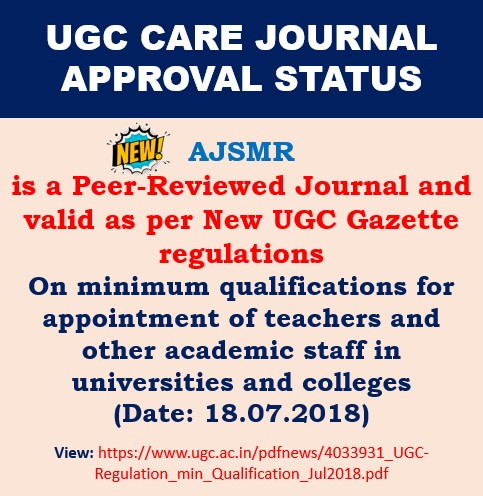Original Research Article I Volume 3 I Issue 2 I 2017
Anticancer activity of crude extracts from leaves of Artocarpus heterophyllus
Veenavani Marka, Madhu Kamarapu, Ravulakolanu Vanisree and Prameela Devi Yalavarthy
The American Journal of Science and Medical Research; 3(2); 12-14
DOI:http://dx.doi.org/10.17812/ajsmr3204
Abstract:
The use of traditional medicines and medicinal plants in most developing countries as therapeutic agents for the maintenance of good health has been widely observed. The present study is aimed to study the anticancer activity of crude extracts from leaves of Artocarpus heterphyllus. The methanolic crude extract was prepared by maceration extraction method. The extent of cytotoxicity and anti-proliferative effects in the MCF-7 and MDA-MB-231 cells both in the presence and the absence of the leaf extract was determined by the MTT dye reduction assay. The crude extracts of this plants at 62.5 µg/ml did not significantly induce cell death (p>0.05, data not shown) comparing the control group. Artocarpus heterophyllus plant methanolic crude extract significantly had cytotoxic effects to the MCF-7 and MDA-MB-231 cells (p<0.05) comparing to the control group. This plant extract at 1000 µg/ml showed the highest cytotoxic effect (20.81±0.36% of viable cells) with IC50 119 µg/mL. Most of the cells at 1000 μg/ml of extract lost their typical morphology and appeared smaller in size, shrunken, and rounded. This study concludes that, the promising baseline information for the potential uses of the methanol extracts of leaves of Artocarpus heterophyllus as an anti-cancer agent.
Keywords:
Anticaner, Artocarpus heterophyllus, MTT assay, MCF-7, MDA-MB-231.
References:
[1]. A.M. Rahman, N. Nahar, AJ. Mian and M. Mosihuzzaman.1999.Variation of carbohydrate composition of two forms of fruit from jack tree (Artocarpus heterophyllus L) with maturity and climatic conditions. Food Chem. 65: 91-97.
[2]. Beier, R.C. and E.H. Oertli, 1983. Psoralen and other linear furocoumarins as phytoalexins in celery.
Phytochemistry., 22:2595–2597.
[3]. Dragsted, L.O., 1998. Natural antioxidants in chemoprevention. Arch. Toxicol., 20 (suppl.): 209–226.
[4]. Halliwell B, Gutteridge JMC. 1999. Free radicals in biology and medicine. Oxford Univ. Press, Oxford
[5]. Hocman, G., 1989. Prevention of cancer: vegetables and plants. Comp. Biochem. Physiol., 93B: 201–212. 4. Agarwal, R., Katiyar, S. K., Khan, S. G., and Mukhtar, H., 1993. Protection against ultraviolet B radiation-induced effects in the skin of SKH-1 hairless mice by a polyphenolic fraction isolated from green tea. Photochem. Photobiol., 58: 695-700.
[6]. Matsuo M, Sasaki N, Saga K, Kaneko T. Cytotoxicity of flavonoids toward cultured normal human cells. Biol. Pharm. Bull. 2005; 28(2) 253—259.
[7]. Nordberg J and Amer ES. 2001. Reactive oxygen species, antioxidants, and the mammalian thioredoxin system. Free Radic. Med. 31:1287-1312
[8]. Ohmagari, K. and F. Berkes. 1997. Transmission of indigenous knowledge and bush skill among the Western James Bay Cree women of subarctic Canada. Human Ecology. 25:197-222.
[9]. Padma P.R and Sharmila K. 2013. Anticancer Activity Of Artemisia Vulgaris On Hepatocellular Carcinoma (Hepg2) Cells., International Journal Of Pharmacy And Pharmaceutical Sciences. 5(3):479-483.
[10]. Perchellet, J.P. and Perchellet,E.M., 1989. Antioxidants and multistage carcinogenesis in mouse skin. Free Radic. Biol. Med., 7: 377–408...
Article Dates:
Received: 19 March 2017; Accepted: 21 May, 2017; Published: 24 June 2017
How To Cite:
Veenavani Marka, Madhu Kamarapu, Ravulakolanu Vanisree and Prameela Devi Yalavarthy (2016). Anticancer activity of crude extracts from leaves of Artocarpus heterophyllus. The Ame J Sci & Med Res, 3(2):12-14;. doi:10.17812/ajsmr3204.



